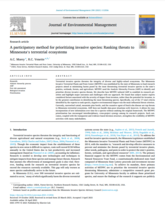The Minnesota Invasive Terrestrial Plants and Pests Center (MITPPC) uses a prioritized funding model to evaluate terrestrial invasive species that pose the greatest threat to Minnesota. We identify the top highly ranked species of each land-based plants, pathogens, and invertebrates. These are eligible for research funding.
The goals of our approach are to be fair, transparent, and responsive in our assessment of terrestrial invasive species that threaten Minnesota.
We focus on terrestrial invasive invertebrates (like insects and earthworms), plant pathogens (viruses, bacteria, fungi, phytoplasmas, nematodes, and parasitic plants), and plants that harm valued plants.
How we rank invasive species
We use a systematic, science-based ranking system to evaluate terrestrial species of concern. The process has 17 criteria that would be most useful to measure the threat an invasive species might pose to Minnesota if left unmanaged.
Each species is rated for each criterion. We then put all the ratings into a computer program that calculates an overall ranking for a species, relative to all other species evaluated. The higher the ranking, the greater the threat a species may pose. The top third of species of each plants, pathogens, and invertebrates are eligible for research funding from MITPPC.
We continually evaluate additional species and refine our process for completeness and accuracy. At least every 2 years, we update the list of species prioritized for research. The update reflects new species that have been evaluated and any new information that may affect the ratings of previously evaluated species.

The following paper provides deeper insight about our prioritization methods and results. It is free to download: A participatory method for prioritizing invasive species: Ranking threats to Minnesota's terrestrial ecosystems (Journal of Environmental Management, 2021).
Evaluations
Once MITPPC has evaluated a species, we compile the information in a PDF and make it available for anyone to view. So far, we have evaluated over 210 species. We update evaluations if/when new new information becomes available.
View completed evaluations (Google Sheet)
How to give feedback
We welcome feedback on species evaluations. You may comment on an existing evaluation or submit a species we have not yet evaluated.
Contact
For questions or other feedback, please email [email protected].